Now-a-days, companies are going global. Thus, there is a constant need to train and educate the workforce regarding the prerequisite skills and expertise required for the future tasks to be performed. Japan is a pool of hi-end companies, including Sony, Mitsubishi, Toshiba, Casio, Canon, Honda and Toyota. The major success of Japan is contributed by their qualified and trained workforce. Thus, the need to avail premium Japanese Translation Services becomes more evident. Indian and other multi-cultured entrepreneurs, thus facilitate translating the e-learning courses into/from Japanese to transform their personnel into the most efficient one. However, eLearning translation needs prior planning.
Listed below are few strategies or tactics to ensure a better translation output:-
1. Language Strategy
Language plays a major role in translations. You need to perfectly tailor the e-learning course in line with the target audience. For instance, translating a course into English requires utmost consideration to the accent and spellings utilized in the different versions of English (American English, British English, Indian as well as Australian versions).
[ Related Resource: The Role of Translator in Japanese Translation Services Agency ]
2. Instructional Strategy
Instructional strategy includes various aspects such as avoiding text heavy content and very long sentences. Avoid using phrases and slangs; instead use bullet points to describe the simpler sentences. This reduces costs and future difficulties.
3. Visual Design Strategy
Never embed the text in images. It consumes more resources as well as results the in duplication of work. Using the text above or below the image would be a better practice to follow. Don’t use symbols or colors that have cultural connotation.
4. Audio Strategy
The voice Tone in the eLearning course determines the extent of influencing your workforce. Audio Strategy aims at using a voice that has balance of personal as well as professional tone to suit the diverse learners. This strategy also keeps the costs low.
5. Development Strategy
Since the Length of texts and words is different in different languages, therefore Devoting space to support a variety of languages is a major problem in developing multilingual e-learning courses. The higher the complexity in originating a course, the higher will be the expenses borne to translation. Hence adopt development strategy precisely for minimizing the complexity of the course.
6. Outsourcing Strategy
When you are planning to provide the source files to market vendors or clients, make sure that your content is tidy for the vendor to find the localizable text. Thus, outsourcing authentic Japanese Translation Services can be beneficial for your firm, in terms of costs and authenticity of the translated training material.
Thus, having pre-defined strategies for visual/audio design, language, instructional design for the precise course development as well as outsourcing it to a leading translation company will ensure a smooth and flawless translation process.

One thought on “6 strategies in Japanese Translation Services for ELearning”